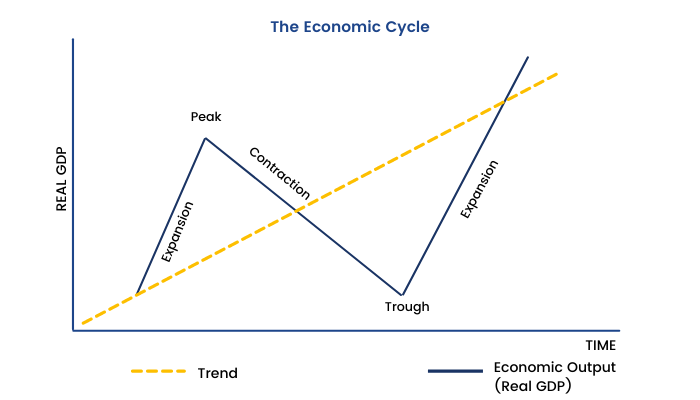Phases of an Economic Cycle
After understanding the liquidity flow and the economic groups, we now need to understand the different phases of an economy to grasp the sector rotation concept. The economy as well as the stock markets always move in cycles or phases. Understanding this cycle or phase is important as each of these phases have distinctive characteristics and accordingly different sectors of the economy react to them. There are five distinct phases of economic cycle:
1. Expansion Phase: Expansion is a phase where the business activities all around increase and operate in full momentum. This results in the GDP (Gross Domestic Product) to grow and we see a rise in employment, consumer confidence and other macroeconomic factors. Equity markets normally do well in this phase and so it's also referred to as an economic recovery.
2. Peak: Peak is the highest point of the economic cycle when the business activities are soaring to new highs every day. This is the phase between the end of the expansion and the beginning of the contraction cycle. The peak period is characterized by an all-round optimism in the economy—income, employment, output and price level all tend to rise. Investments also rise in the economy.
3. Contraction: Contraction phase of the economic cycle follows the peak and marks the onset of the business activity decline. The overall economy also starts indicating a downward trend. During the contraction phase not only there is a fall in GDP but also the level of employment is reduced. Investment also decreases causing further fall in consumption of goods and services.
4. Recession: The recession in a business cycle is a contraction phase that depicts a general slowdown in the activities is intensifying. The macroeconomic indicators like GDP, investment spending, capital expenditure and per capita income reduces and negative indicators such as joblessness, inflation and bankruptcy are on a rise. During this phase the demand of firms and households for goods and services start to fall. No new industries are set up. Sometimes, existing industries are shut down.
5. Trough: Trough marks the end of a recession and the transition phase into expansion. In short, it is the turning point in the economic cycle after the end of a downward spiral of activity. The stock market, just like the economy, also goes through a cycle which consists of four phases.
The stock market cycles are closely related to the economic cycle and phases. The stock market cycle occurs ahead of the economic cycle because investors anticipate economic impact beforehand. It lasts somewhere from a week to a few years.



